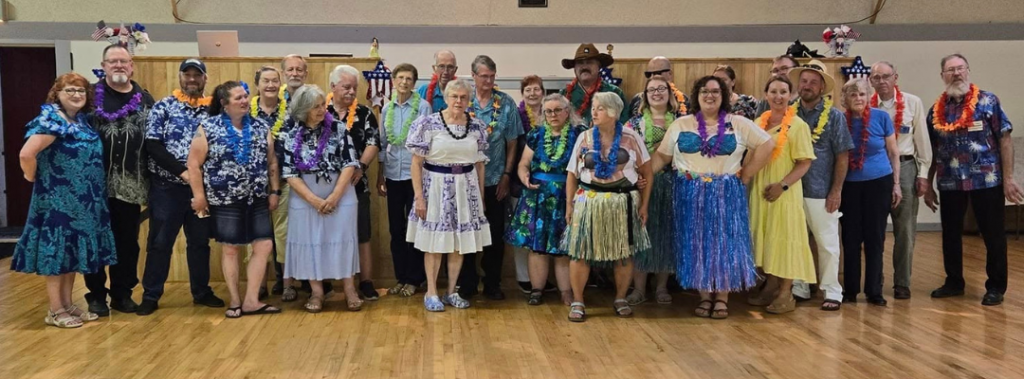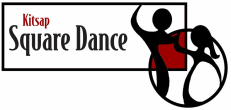
About the Kitsap Square Dance Clubs
Youth. Adults. Seniors. Home schoolers. Kitsap Square Dance Clubs are all about creating wholesome, active fun for every age, interest level, and ability. Square dancing promotes self-esteem, coordination and peer contact.
Today’s square dancing is so much more than gingham and fiddles: dancers come from all walks of life and move to modern music—ranging from Classic Rock, Top 40, and “Golden Oldies,” to Country, and even Latin. Everyone can find his or her favorite music at a Square Dance today.
Just as square dancing music is a blend of styles, so are the dancers, with everyone from company CEOs to stay-at-home moms, students, and retirees, all having a good time together. It doesn’t matter who you are, or what you do… all that’s necessary is that you like having a good time with friendly people.
Kitsap Square Dance Clubs have been around for over 50 years, offering dance classes, events, and other community activities from our facility located on the Old Belfair Highway, Conveniently located between Kitsap and Mason counties on the Kitsap peninsula in Washington state.
Our goal is to provide a setting where the dancers can achieve a sense of accomplishment and at the same time just have some great fun.
History of Square Dancing
Square dances were first documented in 17th-century England, but versions of the dance were also found in France and throughout Europe.
Square dancing came to North America with the first settlers. When the pioneers came west, they brought a dance form called the quadrille, which means “square” in French. The pioneers preferred using the simpler word, and so the square dance was born.
In some countries and regions, through preservation and repetition, square dances have attained the status of a folk dance, with the Western American square dance being perhaps the most widely known form worldwide, likely due to its association with the romanticized image of the American cowboy. As a result, square dancing is strongly associated with the United States, with nineteen U.S. states having designated it as their official state dance—including Washington state, on April 17, 1979!
Today’s Square Dance
There are organized square dance clubs all over the world and they include teen square dance clubs, camping square dance clubs, gay square dance clubs, singles square dance clubs, and family square dance clubs.
Wear a FitBit? One evening of square dancing can equal THREE TO FIVE miles of walking and burn 300 to 800 calories. Even bigger bonus: you can’t think about the day’s worries when you are listening for, and responding to, square dance calls.
In short, you’ve got nothing to lose and plenty to gain: better health, lots of new friends, loads of laughter, added self-esteem, and a fun, music-filled alternative form of recreation.
Why Square Dance?
Top 10 Reasons to Square Dance
from the US Square Dancers Association website
1. Social Activity – Square Dancing is a great way to meet people in a non-threatening, relaxed social atmosphere. You never know who you are gong to meet. Lifelong friendships are formed, and many have met the love of their life. There are clubs for singles, couples, the handicap able, gays & lesbians, campers, and youth, although usually everybody is welcome at all clubs.
2. Healthy Environment – Square Dance & Round Dance clubs are smoke and alcohol free.
3. Stress Relief – Since these dance forms, Square Dancing and Round Dancing, are all led by a leader giving commands, you become so focused on the “task at hand” that your other mental worries are forgotten, at least for a couple of hours.
4. Cardiovascular Workout – Dancing is a safe way to exercise. The level of exertion is up to each participant. You can rev it up for a high intensity workout or take it easy for a relaxing, yet beneficial workout. Dancing regularly can lead to a slower heart rate, lower blood pressure, and an improved cholesterol profile.
5. Healthy Brain Activity – Square and Round, dancers react to calls as they are given. This forces the body and brain to be tightly coordinated. A number of the calls are memorized which keeps the brain sharp. Studies have shown that activities that involve both physical and mental activity at the same time help to slow the onset of Alzheimer’s disease.
6. Calorie Burn – Dancing burns between 200 and 400 calories every 30 minutes of dancing. That’s equivalent to walking or riding a bike.
7. Redline Your FitBit – The President’s Council on Physical Fitness and Sports recommends 10,000 steps per day to maintain physical fitness. It is estimated that a typical square dancer can expect to clock 9,000 to 10,000 steps per dance.
8. Strengthen Bones – The side to side movements of dancing strengthen weight-bearing bones, tibia, fibula, and femur, and help prevent the slow loss of bone mass.
9. Fun Form of Rehabilitation – Dancing is a way to get back in the swing of things if you are recovering from an injury. Dancing keeps your joints moving, and is nice alternative to jogging or other high-intensity activities.
10. Improved Balance – Studies have shown that adults who have a history of activities such as dance, tend to have fewer incidents of falling as they get older.

